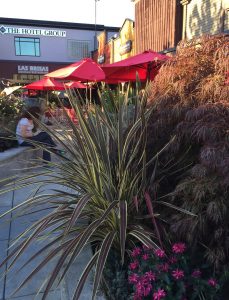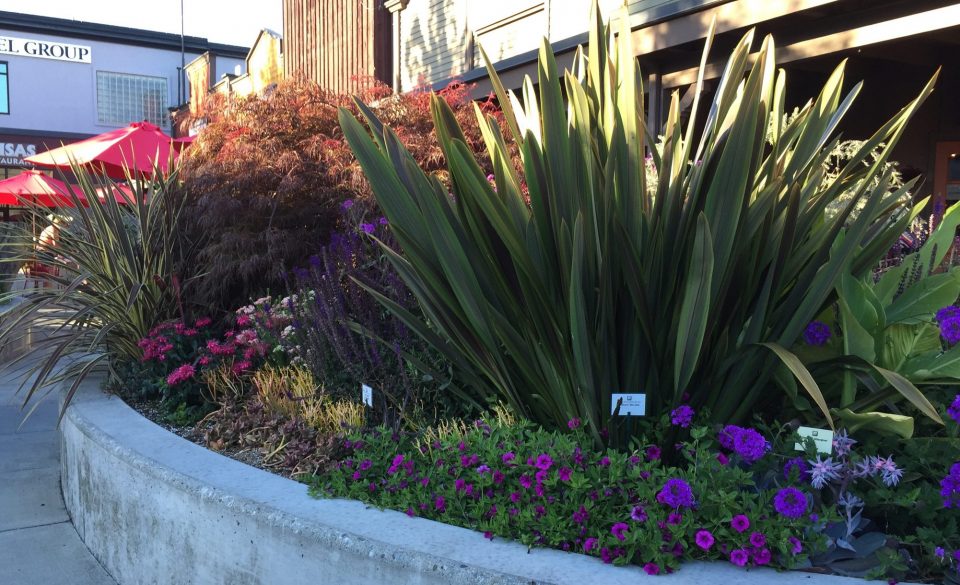The Sea Jade Bed
 Retaining its name from 2015, Sea Jade features some spectacular plants that have overwintered from last year’s test garden. Chief among them are the grass-like Phormium ‘Sea Jade’ and Cordyline ‘Electric Flash.’ Each clump is now TRIPLE the size of the what we planted in May 2015! ‘Electric Flash’ is a newer introduction, and its tricolor blades still continue to pair well with a rainbow of different hues.
Retaining its name from 2015, Sea Jade features some spectacular plants that have overwintered from last year’s test garden. Chief among them are the grass-like Phormium ‘Sea Jade’ and Cordyline ‘Electric Flash.’ Each clump is now TRIPLE the size of the what we planted in May 2015! ‘Electric Flash’ is a newer introduction, and its tricolor blades still continue to pair well with a rainbow of different hues.
Both of our Melaleuca incana have also overwintered extremely well and are thriving here. At first glance, you might mistake this plant for something like a dwarf Cedrus deodara, but upon closer inspection, you’ll pick up its beautiful blue-gray color and purplish new tip growth. Touch it and it’ll feel completely unlike a conifer—it’s rather wispy and velvet soft. Commonly called Grey Honey-Myrtle, Melaleuca is also a member of the Myrtaceae family (like the Calothamnus nearby in the Night Sky planting). On our trips to California, we’ve admired its citron-colored bottlebrush blooms and are eager to see when it might put on this display in Edmonds. In this bed, we’re loving how it gently arches through this layered planting, and love its blue color against the dark crimson backdrop of the Japanese laceleaf maple.
This bed is also well-stocked with varieties of Echeveria, a group of plants we chose to highlight this year. Though we are interested in testing the hardiness of different varieties, we are more interested in seeing how they perform in mass plantings in the PNW garden over the course of a few seasons. At the north end there is a group of Echeveria agavoides, green rosettes edged in red, pointed leaves. This species is native to Mexico and is found in higher elevations; thus, it’s hardier than you might guess (15-20 degrees) and may survive our winters, depending on rainfall.
The south end of the bed is highlighted by purple cultivars: two large Echeveria ‘Afterglow’ and a group of Echeveria ‘Perle von Nürnberg.’ These beauties illustrate some of the amazing colors of genus Echeveria and also feature a white, powdery protective cover to their leaves called pruinose, which gives the plants a certain translucence. Most of these purple cultivars are slightly less hardy (20-25 degrees). In the nearby Night Sky planting, you’ll also see a couple of other Echeveria varieities: Echeveria ‘Black Knight’ and Echeveria ‘Grey/Red,’ also chosen to showcase the range of the genus and monitor PNW longevity and bloom time.
Ozothmanus ‘Dark Pink’ is planted here to trial against ‘Radiance’ (located in Night Sky & Sunburst). Along with this unusual annual, we’ve selected the white-blooming vine Lophospermum ‘Lofos White,’ Chrysanthemum (Rhodanthemum) hosmariense ‘Morocco,’ and Brachyscome ‘Surdaisy Pink,’ to offer some new ideas for annual color and long-blooming container selections.
And finally, a little inside joke at HMP: tucked into the south end are a trio of Musella lasiocarpa, a dwarf Chinese banana, or Golden Lotus banana. We planted these unusual banana relatives as a surprise in jest for our friends at The Cheesemonger, who eagerly watched our red banana grow monstrously larger by the day last summer. Surprise! These plants will only grow 3-4’!! What’s the coolest thing about this plant? They BLOOM. The flower looks something like a yellow Protea or Artichoke: a giant single, yellow strawflower atop the plant. We’re not sure if we’ll see them bloom in Edmonds this year, but since they hail from mountainous areas of Yunnan Province in China, they are hardy to 0-10 degrees and should easily remain in this garden until they mature.
